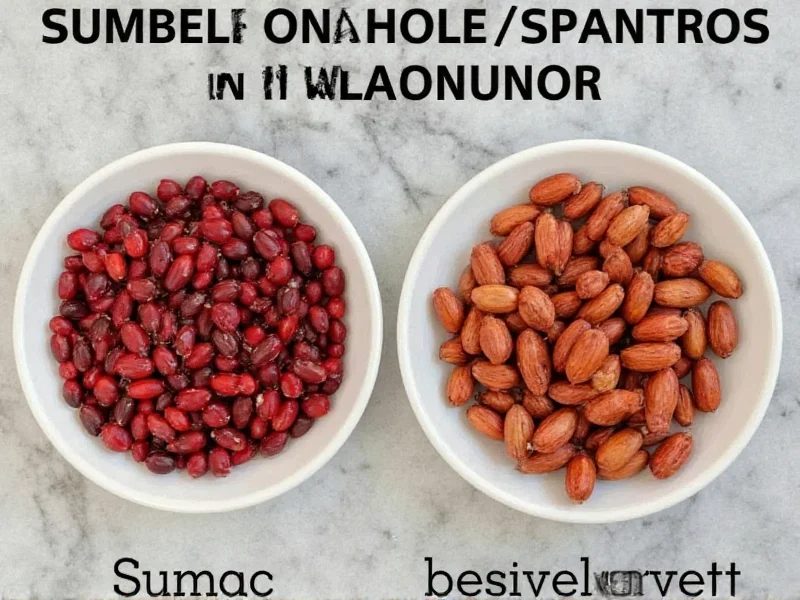When you need a sumac substitute for your recipe, understanding what makes sumac unique is crucial. Sumac, a deep red Middle Eastern spice made from ground berries, offers a distinctive tangy, lemony flavor with subtle earthy notes. This versatile spice appears in dishes like fattoush salad, grilled meats, and rice pilafs. When sumac isn't available, choosing the right alternative depends on whether you need its tartness, color, or both.
Understanding Sumac's Flavor Profile
Sumac provides a unique combination of qualities that make substitution challenging. Its primary characteristics include:
- Bright, citrus-like tartness (pH around 2.5-3.0)
- Earthy, slightly floral undertones
- Vibrant burgundy-red color
- Moderate astringency without bitterness
When selecting a sumac replacement, consider which of these elements matters most for your specific recipe. A salad dressing primarily needs the tartness, while a dish like musakhan requires both flavor and color.
Top Sumac Substitutes Ranked by Effectiveness
Not all sumac alternatives work equally well across different applications. Here's how the most common substitutes compare for various culinary needs:
| Substitute | Best For | Tartness Match | Color Match | Recommended Ratio |
|---|---|---|---|---|
| Lemon juice + zest | Dressings, marinades, tabbouleh | Excellent | Poor | 1 tbsp juice + 1 tsp zest = 1¼ tsp sumac |
| Amchoor (mango powder) | Indian/Middle Eastern fusion, dry rubs | Very Good | Poor | 1 tsp amchoor = 1¼ tsp sumac |
| Vinegar + paprika | Rice dishes, stews, musakhan | Good | Excellent | ¼ tsp vinegar + ¼ tsp paprika = 1 tsp sumac |
| Za'atar (without sumac) | Bread dips, roasted vegetables | Fair | Good | 1½ tsp za'atar = 1 tsp sumac |
| Tamarind paste | Complex sauces, braises | Fair | Good | 1 tsp tamarind = 1¼ tsp sumac |
Detailed Analysis of Each Sumac Alternative
Lemon Juice and Zest: Best Overall Substitute
For most recipes requiring sumac's signature tartness, fresh lemon juice combined with zest provides the closest flavor match. The citric acid mimics sumac's pH level while the zest contributes aromatic compounds similar to sumac's floral notes. This combination works particularly well in:
- Fattoush salad dressing (replace 1¼ tsp sumac with 1 tbsp lemon juice + 1 tsp zest)
- Grilled chicken or fish marinades
- Tabbouleh and other herb salads
Limitations: Lemon juice lacks sumac's deep red color and introduces additional liquid, which may affect texture in dry rubs or spice blends.
Amchoor (Dried Mango Powder): Best Dry Substitute
Amchoor, a staple in Indian cuisine, offers remarkable tartness without adding moisture. Made from dried green mangoes, it provides a clean sourness that closely resembles sumac's primary characteristic. Use amchoor when:
- You need a dry spice replacement for rubs or spice blends
- Preparing dishes where liquid content matters (like dry spice mixes)
- Creating vegan "feta" cheese alternatives
Pro tip: For Middle Eastern recipes, combine amchoor with a pinch of smoked paprika to better approximate sumac's earthy notes.
Vinegar and Paprika Blend: Best for Color and Flavor Balance
When both color and tartness matter, a combination of apple cider vinegar and sweet paprika creates an effective sumac alternative. The vinegar provides acidity while paprika contributes color and subtle sweetness. This works especially well for:
- Musakhan (Palestinian sumac-spiced chicken dish)
- Rice pilafs needing reddish hue
- Roasted vegetable seasonings
Mix ¼ teaspoon vinegar with ¼ teaspoon paprika to replace 1 teaspoon of sumac. For stronger dishes like stews, increase to 1:1 ratio.
Za'atar: Context-Specific Alternative
While za'atar contains sumac as a primary ingredient, some blends omit it or use minimal amounts. Check your blend first. When using za'atar as a substitute:
- Use 1½ teaspoons za'atar for every 1 teaspoon sumac
- Best for bread dips and roasted vegetables
- Not recommended for dishes where sumac's tartness is primary flavor
Remember that za'atar introduces additional flavors (thyme, oregano, sesame) that alter the dish's profile.
Substitution Guidelines by Cuisine
Different culinary traditions use sumac in specific ways, requiring tailored substitution approaches:
Middle Eastern Cuisine Substitutions
For authentic Middle Eastern dishes like fattoush or musakhan:
- Fattoush salad: Use lemon juice and zest (1 tbsp juice + 1 tsp zest per 1¼ tsp sumac)
- Musakhan: Combine apple cider vinegar with sweet paprika (1:1 ratio)
- Grilled meats: Amchoor works well for dry rubs (1:1 substitution)
Mediterranean and Fusion Cooking
In Mediterranean recipes or fusion dishes:
- Salad dressings: Lemon juice provides best results
- Vegetable roasts: Vinegar-paprika blend maintains color
- Seafood preparations: Tamarind paste offers complex sourness
Common Substitution Mistakes to Avoid
When replacing sumac in recipes, watch out for these common errors:
- Using only lemon juice without zest - misses sumac's aromatic complexity
- Overcompensating with vinegar - creates harsh acidity rather than sumac's mellow tartness
- Ignoring color requirements - crucial for dishes like musakhan where sumac's red hue is essential
- Using smoked paprika instead of sweet - introduces overpowering smokiness
- Not adjusting liquid content - adding too much juice/vinegar can ruin texture
Creating Your Own Sumac-Style Blend
For frequent sumac users without access to the spice, create a custom blend:
- Mix 2 parts sweet paprika
- Add 1 part amchoor (mango powder)
- Include ¼ part dried lemon zest
- Store in airtight container for up to 3 months
This blend works well as a 1:1 replacement in most recipes, though it won't perfectly replicate authentic sumac's nuanced flavor.
Where to Find Quality Sumac
Before resorting to substitutes, consider these reliable sources for genuine sumac:
- Middle Eastern grocery stores (often sold in bulk)
- Specialty spice retailers (look for Iranian or Lebanese varieties)
- Online spice merchants with freshness guarantees
When purchasing, check for deep burgundy color and avoid dull brown varieties, which indicate age and diminished flavor.











 浙公网安备
33010002000092号
浙公网安备
33010002000092号 浙B2-20120091-4
浙B2-20120091-4